Amati is the last name of a family of Italian violin makers who lived at Cremona from about 1538 to 1740. Their importance is considered equal to those of the Bergonzi, Guarneri, and Stradivari families. Today, violins created by Nicolò Amati are valued at around $600,000. Because of their age and rarity, Amati instruments are mostly kept in museum or private collections and are seldom played in public.

Cremona is a city and comune in northern Italy, situated in Lombardy, on the left bank of the Po river in the middle of the Pianura Padana. It is the capital of the province of Cremona and the seat of the local city and province governments. The city of Cremona is especially noted for its musical history and traditions, including some of the earliest and most renowned luthiers, such as Giuseppe Guarneri, Antonio Stradivari, Francesco Rugeri, Vincenzo Rugeri, and several members of the Amati family.
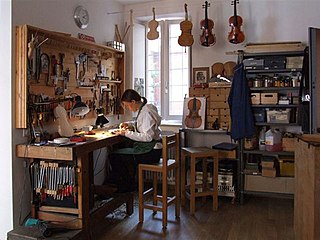
A luthier is a craftsperson who builds or repairs string instruments that have a neck and a sound box. The word "luthier" is originally French and comes from the French word for lute. The term was originally used for makers of lutes, but it came to be used already in French for makers of most bowed and plucked stringed instruments such as members of the violin family and guitars. Luthiers, however, do not make harps or pianos; these require different skills and construction methods because their strings are secured to a frame.

The Province of Cremona is a province in the Lombardy region of Italy. Its capital city is Cremona.

Antonio Campi was an Italian painter of the Renaissance.

Alessandro Tiarini was an Italian Baroque painter of the Bolognese School.

Soncino is a comune (municipality) in the Province of Cremona in the Italian region Lombardy, located about 60 kilometres (37 mi) east of Milan and about 30 kilometres (19 mi) northwest of Cremona.

Simone Fernando Sacconi was an expert Italian violin maker and restorer who studied fellow luthier Antonio Stradivari extensively during his lifetime.
Andrea Teodoro Zani was an Italian violinist and composer.

Giuseppe Fiorini (1861–1934) was an Italian luthier and is considered one of the most important Italian violin makers. He built his first instrument at the age of 16 while working in Bologna. He established Rieger and Fiorini in Germany from 1888, then lived in Zurich during World War 1 and Rome from 1923.
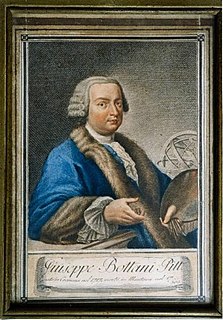
Giuseppe Bottani was an Italian painter active in the Baroque period.
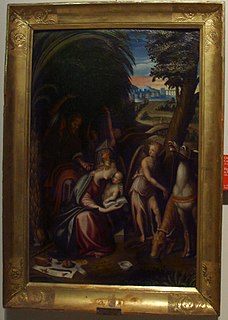
Giulio Calvi was an Italian painter of the Renaissance. He was born in Cremona, and active there and at Soncino. He was a pupil of Giovanni Battista Trotti.

Antonio Barbalonga or Barbalunga, also called Antonio Alberti, was an Italian painter of the Baroque period.
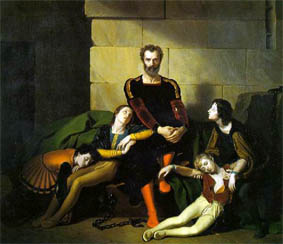
Giuseppe Diotti was an Italian painter of the Neoclassic style.
Paulus Barbus was an Italian Dominican philosopher and theologian.

Nicola Amati, Nicolò Amati or Nicolao Amati was an Italian master luthier from Cremona, Italy. Amati is one of the most well-known luthiers from the Casa Amati. He was the teacher of illustrious Cremonese School luthiers such as Andrea Guarneri and Giovanni Battista Rogeri. While no clear documentation exists for their being apprentices in his shop, Amati may also have apprenticed Antonio Stradivari, Francesco Rugeri, and Jacob Stainer, as their work is heavily influenced by Amati.
Corna usually refers to the sign of the horns, a hand gesture.
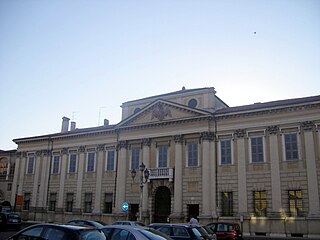
The Palazzo D'Arco is a Neoclassical-style palace located on Piazza Carlo D'Arco #4 in Mantua, region of Lombardy, Italy. The palace houses the Museo di Palazzo d'Arco, which displays the furnishings and artwork collected by the Duke D'Arco.
The following is a timeline of the history of the city of Cremona in the Lombardy region of Italy.
The Stampa are a well-known family of old Italian nobility that rose to prominence in the 15th century. They were Grandees of Spain, members the Order of the Golden Fleece and owned many estates throughout the Italian Peninsula, including a Castle in Soncino, a Palace in Milan, and countless others in Muggiò, Melzo, Gorgonzola, Rivolta d'Adda, Ferentino and Rome. They are related to some of the most important Italian noble houses, such as the Doria, Sforza, Gonzaga, Borromeo and Visconti.
















